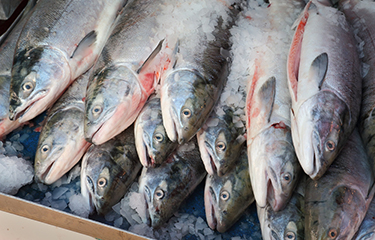Values continue to rise for the sockeye salmon fishery in Bristol Bay, Alaska as a record string of runs coincides with a strong sockeye salmon market.
According to final figures released by the Alaska Department of Fish and Game (ADFG) this fall, last season’s run – the largest ever in Bristol Bay – topped 71 million fish, with a catch of over 42 million sockeye.
“If you lined those fish up nose to tail, that’s enough to encircle the entire lower 48 not once, but twice. It’s just huge volumes of fish coming back to Bristol Bay right now,” Bristol Bay Regional Seafood Development Association Executive Director Andy Wink told SeafoodSource.
For the upcoming season, biologists from both ADFG and the University of Washington Fisheries Research Institute predicted the fishery will again see over 70 million fish, and that the run would likely top the 2021 record. Greg Buck, an ADFG area management biologist who works on his department's annual sockeye forecast, told SeafoodSource he and his colleagues have had to adjust their predictions to what seems to be a new regime.
“It’s big. It’s the largest we’ve ever forecasted. Enough new data has come in that some of these models that we were guessing at for the last couple years start to look credible, so we went with them,” Buck told SeafoodSource.
The recent runs are far larger than historical averages in Bristol Bay. For the past six seasons, the total sockeye run in Western Alaska’s fisheries has topped 50 million fish, well above the average of under 36 million from 1962 to 2021. ADFG’s forecast said there should be 60 million sockeye available for harvest next season, which would be 75 percent greater than the most recent 10-year average harvest of 34.24 million, and 170 percent greater than the long-term average harvest of 22.22 million fish since 1963.
Wink said the huge runs are lining up with other factors, including a fishery-wide push toward better handling and a shift from cans to fillets, to increase overall value.
“Not only is the fishery really abundant, but market demand is very good and quality has improved a lot. There are so many things that factor into value and those things have kind of lined up, especially over the past five or six years,” Wink told SeafoodSource.
The strong market was validated recently when major processors Peter Pan Seafoods and Silver Bay Seafoods bumped up their base buying-price from already-strong USD 1.25 (EUR 1.11) to USD 1.45 (EUR 1.29) per pound for sockeye.
According to figures provided by BBRSDA, the ex-vessel value of the fishery has been on an upward trend for the last five years, with the five-year average ex-vessel price for sockeye up 54 percent and the total ex-vessel value up 92 percent, from USD 175 million (EUR 155 million) in 2015 to USD 282 million (EUR 250 million) in 2020.
The increased values are reflected in permit prices. The most conservative figures show Bristol Bay drift permits have risen USD 106,000 (EUR 94,000) since 2006, while all other Alaska salmon permits have increased less than USD 20,000 (EUR 18,000) on average in the same span. According to brokers, this winter, drift permits were selling for up to USD 215,000 (EUR 191,000), while setnet permits were selling for around USD 85,000 (EUR 75,500), which was up USD 25,000 (EUR 22,000) from last season.
“That’s probably the highest they’ve been since the mid-90s,” Wink said.
Even with more fish being caught and sold, strong global demand for sockeye has resulted in wholesale prices reaching near-record highs, according to Wink. In July and August, in the middle of the season, first wholesale prices on frozen H&G sockeye from Bristol Bay were at USD 4.37 (EU 3.88), up USD 1.07 (EU 0.95) from the previous season. Prices were higher at the seafood counter as well during the third fiscal quarter of 2021, with the average Bristol Bay fillet selling for USD 12.94 (EU 11.49), up from USD 11.99 (EU 10.65) during the same period last year.
BBRSDA said prices for sockeye salmon fillets sat at USD 6.61 (EU 5.87) over the summer, with anecdotal reports of direct marketers fetching over USD 9.00 (EU 8.00).
“We’ve seen product moving and the data reflects that. Anecdotally, it seems like the market is tighter for frozen sockeye than it has been at this time of year in a while. That underscores how much demand there is out there,” Wink said. “I think there are a lot of buyers trying to ensure they have enough product to service their programs.”
Photo courtesy of Max Lindenthaler/Shutterstock







